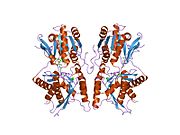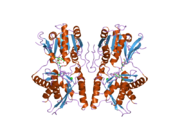NPR3
Izgled
| edit |
| Natriuretski peptidni receptor C/guanilat ciklaza C (atrionatriuretski peptidni receptor C) | |||||||||||
|---|---|---|---|---|---|---|---|---|---|---|---|
 PDB prikaz baziran na 1yk0. | |||||||||||
| Dostupne strukture | |||||||||||
| 1yk0, 1jdp, 1yk1, 1jdn | |||||||||||
| Identifikatori | |||||||||||
| Simboli | NPR3; GUCY2B; NPRC; ANPRC | ||||||||||
| Vanjski ID | OMIM: 108962 MGI: 97373 HomoloGene: 699 GeneCards: NPR3 Gene | ||||||||||
| |||||||||||
| Ortolozi | |||||||||||
| Vrsta | Čovek | Miš | |||||||||
| Entrez | 4883 | 18162 | |||||||||
| Ensembl | ENSG00000113389 | ENSMUSG00000022206 | |||||||||
| UniProt | P17342 | P70180 | |||||||||
| RefSeq (mRNA) | NM_000908 | NM_008728 | |||||||||
| RefSeq (protein) | NP_000899 | NP_001034270 | |||||||||
| Lokacija (UCSC) | Chr 5: 32.71 - 32.79 Mb | Chr 15: 11.77 - 11.84 Mb | |||||||||
| PubMed pretraga | [1] | [2] | |||||||||
Natriuretski peptidni receptor C (atrionatriuretski peptidni receptor C, NPR3) je receptor atrijalnog natriuretskog peptida. Ovaj receptor je kod čoveka kodiran NPR3 genom.[1]
Familija natriuretskih peptida vrši brojne vaskularne, renalne, i endokrine funkcije održavanja krvnog pritiska i zapremine ekstracelularnog fluida. Ta dejstva su posredovana specifičnim vezivanjem peptida za receptore na površini ćelija u vaskulaturnom sistemu, bubrezima, adrenalnoj žlezdi, i mozgu.[1]
- Fox AA, Collard CD, Shernan SK, et al. (2009). „Natriuretic peptide system gene variants are associated with ventricular dysfunction after coronary artery bypass grafting.”. Anesthesiology 110 (4): 738–47. DOI:10.1097/ALN.0b013e31819c7496. PMC 2735337. PMID 19326473.
- Moffatt P, Thomas G, Sellin K, et al. (2007). „Osteocrin is a specific ligand of the natriuretic Peptide clearance receptor that modulates bone growth.”. J. Biol. Chem. 282 (50): 36454–62. DOI:10.1074/jbc.M708596200. PMID 17951249.
- Pitzalis MV, Sarzani R, Dessì-Fulgheri P, et al. (2003). „Allelic variants of natriuretic peptide receptor genes are associated with family history of hypertension and cardiovascular phenotype.”. J. Hypertens. 21 (8): 1491–6. DOI:10.1097/01.hjh.0000084707.87421.35. PMID 12872042.
- Fan D, Bryan PM, Antos LK, et al. (2005). „Down-regulation does not mediate natriuretic peptide-dependent desensitization of natriuretic peptide receptor (NPR)-A or NPR-B: guanylyl cyclase-linked natriuretic peptide receptors do not internalize.”. Mol. Pharmacol. 67 (1): 174–83. DOI:10.1124/mol.104.002436. PMID 15459247.
- He Xl , Chow Dc , Martick MM, Garcia KC (2001). „Allosteric activation of a spring-loaded natriuretic peptide receptor dimer by hormone.”. Science 293 (5535): 1657–62. DOI:10.1126/science.1062246. PMID 11533490.
- Soranzo N, Rivadeneira F, Chinappen-Horsley U, et al. (2009). Visscher, Peter M.. ur. „Meta-analysis of genome-wide scans for human adult stature identifies novel Loci and associations with measures of skeletal frame size.”. PLoS Genet. 5 (4): e1000445. DOI:10.1371/journal.pgen.1000445. PMC 2661236. PMID 19343178.
- Olsen JV, Blagoev B, Gnad F, et al. (2006). „Global, in vivo, and site-specific phosphorylation dynamics in signaling networks.”. Cell 127 (3): 635–48. DOI:10.1016/j.cell.2006.09.026. PMID 17081983.
- He XL, Dukkipati A, Garcia KC (2006). „Structural determinants of natriuretic peptide receptor specificity and degeneracy.”. J. Mol. Biol. 361 (4): 698–714. DOI:10.1016/j.jmb.2006.06.060. PMID 16870210.
- Rubattu S, Stanzione R, Di Angelantonio E, et al. (2004). „Atrial natriuretic peptide gene polymorphisms and risk of ischemic stroke in humans.”. Stroke 35 (4): 814–8. DOI:10.1161/01.STR.0000119381.52589.AB. PMID 15017020.
- Iemitsu M, Maeda S, Otsuki T, et al. (2008). „Arterial stiffness, physical activity, and atrial natriuretic Peptide gene polymorphism in older subjects.”. Hypertens. Res. 31 (4): 767–74. DOI:10.1291/hypres.31.767. PMID 18633189.
- Dickey DM, Yoder AR, Potter LR (2009). „A familial mutation renders atrial natriuretic Peptide resistant to proteolytic degradation.”. J. Biol. Chem. 284 (29): 19196–202. DOI:10.1074/jbc.M109.010777. PMC 2740543. PMID 19458086.
- Gratacòs M, Costas J, de Cid R, et al. (2009). „Identification of new putative susceptibility genes for several psychiatric disorders by association analysis of regulatory and non-synonymous SNPs of 306 genes involved in neurotransmission and neurodevelopment.”. Am. J. Med. Genet. B Neuropsychiatr. Genet. 150B (6): 808–16. DOI:10.1002/ajmg.b.30902. PMID 19086053.
- Aoi N, Soma M, Nakayama T, et al. (2004). „Variable number of tandem repeat of the 5'-flanking region of type-C human natriuretic peptide receptor gene influences blood pressure levels in obesity-associated hypertension.”. Hypertens. Res. 27 (10): 711–6. DOI:10.1291/hypres.27.711. PMID 15785005.
- Anand-Srivastava MB (2005). „Natriuretic peptide receptor-C signaling and regulation.”. Peptides 26 (6): 1044–59. DOI:10.1016/j.peptides.2004.09.023. PMID 15911072.
- Estrada K, Krawczak M, Schreiber S, et al. (2009). „A genome-wide association study of northwestern Europeans involves the C-type natriuretic peptide signaling pathway in the etiology of human height variation.”. Hum. Mol. Genet. 18 (18): 3516–24. DOI:10.1093/hmg/ddp296. PMC 2729669. PMID 19570815.
- Burgess MD, Moore KD, Carter GM, et al. (2009). „C-type natriuretic peptide receptor expression in pancreatic alpha cells.”. Histochem. Cell Biol. 132 (1): 95–103. DOI:10.1007/s00418-009-0591-3. PMID 19352691.
- Vassalle C, Andreassi MG, Prontera C, et al. (2007). „Influence of ScaI and natriuretic peptide (NP) clearance receptor polymorphisms of the NP System on NP concentration in chronic heart failure.”. Clin. Chem. 53 (11): 1886–90. DOI:10.1373/clinchem.2007.088302. PMID 17890443.
- Lee JK, Kim HT, Cho SM, et al. (2003). „Characterization of 458 single nucleotide polymorphisms of disease candidate genes in the Korean population.”. J. Hum. Genet. 48 (5): 213–6. DOI:10.1007/s10038-003-0011-9. PMID 12768436.
- van den Akker F (2001). „Structural insights into the ligand binding domains of membrane bound guanylyl cyclases and natriuretic peptide receptors.”. J. Mol. Biol. 311 (5): 923–37. DOI:10.1006/jmbi.2001.4922. PMID 11556325.
- He XL, Dukkipati A, Wang X, Garcia KC (2005). „A new paradigm for hormone recognition and allosteric receptor activation revealed from structural studies of NPR-C.”. Peptides 26 (6): 1035–43. DOI:10.1016/j.peptides.2004.08.035. PMID 15911071.




